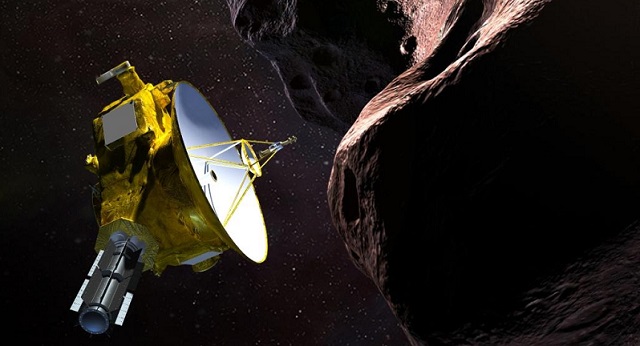
Tampa, United States | AFP | NASA rang in the New Year on Tuesday with a historic flyby of the farthest, and quite possibly the oldest, cosmic body ever explored by humankind — a tiny, distant world called Ultima Thule — in the hopes of learning more about how planets took shape.
“Go New Horizons!” said lead scientist Alan Stern as a crowd including kids dressed in space costumes blew party horns and cheered at the Johns Hopkins Applied Physics Laboratory in Maryland to mark the moment at 12:33 am (0533 GMT) when the New Horizons spacecraft aimed its cameras at the space rock four billion miles (6.4 billion kilometers) away in a dark and frigid region of space known as the Kuiper Belt.
Offering scientists the first up-close look at an ancient building block of planets, the flyby took place about a billion miles beyond Pluto, which was until now the most faraway world ever visited up close by a spacecraft.
Real-time video of the actual flyby was impossible, since it takes more than six hours for a signal sent from Earth to reach the spaceship, and another six hours for the response to arrive.
The first signal back to Earth should come about 10 hours after the flyby, around 9:45 am (1445 GMT), letting NASA know if New Horizons survived the risky, high-speed encounter.
Hurtling through space at a speed of 32,000 miles per hour, the spacecraft aimed to make its closest approach within 2,200 miles of the surface of Ultima Thule.
“This is a night none of us are going to forget,” said Queen guitarist Brian May — who also holds an advanced degree in astrophysics — and who recorded a solo track to honor the spacecraft and its spirit of exploration.
Stern said Ultima Thule is unique because it is a relic from the early days of the solar system and could provide answers about the origins of other planets.
“The object is in such a deep freeze that it is perfectly preserved from its original formation,” he said.
“Everything we are going to learn about Ultima — from its composition to its geology to how it was originally assembled, whether it has satellites and an atmosphere and those kinds of things — are going to teach us about the original formation conditions of objects in the solar system.”
– What does it look like? –
Scientists are not sure what Ultima Thule (pronounced TOO-lee) looks like — whether it is cratered or smooth, or even if it is a single object or a cluster.
It was discovered in 2014 with the help of the Hubble Space Telescope, and is believed to be 12-20 miles in size.
A blurred and pixelated image released Monday, taken from 1.2 million miles away, has intrigued scientists because it appears to show an elongated blob, not a round space rock.
The spaceship was to collect 900 images over the course of a few seconds as it shaved by. Even clearer images should arrive over the next three days.
“Now it is just a matter of time to see the data coming down,” said deputy project scientist John Spencer of the Southwest Research Institute.
Scientists decided to study Ultima Thule with New Horizons after the spaceship, which launched in 2006, completed its main mission of flying by Pluto in 2015, returning the most detailed images ever taken of the dwarf planet.
Stern said the goal is to take images of Ultima that are three times the resolution the team had for Pluto.
– Frontier of planetary science –
Ultima Thule is named for a mythical, far-northern island in medieval literature and cartography, according to NASA.
Project scientist Hal Weaver of the Johns Hopkins Applied Physics Laboratory said humans didn’t even know the Kuiper Belt — a vast ring of relics from the formation days of the solar system — existed until the 1990s.
“This is the frontier of planetary science,” said Weaver.
“We finally have reached the outskirts of the solar system, these things that have been there since the beginning and have hardly changed — we think. We will find out.”
Another NASA spacecraft, OSIRIS-REx, also set a new record on Monday by entering orbit around the asteroid Bennu, the smallest cosmic object — about 1,600 feet (500 meters) in diameter — ever circled by a spacecraft.
NASA said the orbit some 70 million miles (110 million kilometers) away marks “a leap for humankind” because no spacecraft has ever “circled so close to such a small space object — one with barely enough gravity to keep a vehicle in a stable orbit.”
The twin planetary feats coincided with the 50th anniversary of the first time humans ever explored another world, when US astronauts orbited the Moon aboard Apollo 8 in December, 1968.
“As you celebrate New Year’s Day, cast an eye upward and think for a moment about the amazing things our country and our species can do when we set our minds to it,” Stern wrote in the New York Times on Monday.
 The Independent Uganda: You get the Truth we Pay the Price
The Independent Uganda: You get the Truth we Pay the Price



